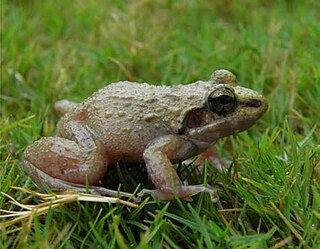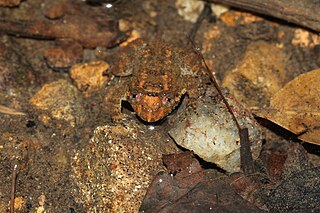
Geocrinia is a genus of frogs in the family Myobatrachidae. These frogs are endemic to Australia. Two species are known from southeastern Australia, while one is known from southeastern Western Australia.

Metacrinia is a genus of frog in the family Myobatrachidae. It is monotypic, being represented by the single species, Metacrinia nichollsi, commonly known as the Forest toadlet or Nicholls toadlet. It is endemic to Southwest Australia, occurring between Dunsborough and Albany.

Indirana leithii is a species of frog in the family Ranixalidae. It is endemic to the northern Western Ghats of India. As currently defined, its range is restricted to the states of Maharashtra and southern Gujarat; earlier records elsewhere refer to other species.

Warren, also known as Karri Forest Region and the Jarrah-Karri forest and shrublands ecoregion, is a biogeographic region in southern Western Australia. Located in the southwest corner of Western Australia between Cape Naturaliste and Albany, it is bordered to the north and east by the Jarrah Forest region. Its defining characteristic is an extensive tall forest of Eucalyptus diversicolor (karri). This occurs on dissected, hilly ground, with a moderately wet climate. Karri is a valuable timber and much of the karri forest has been logged over, but less than a third has been cleared for agriculture. Recognised as a region under the Interim Biogeographic Regionalisation for Australia (IBRA), and as a terrestrial ecoregion by the World Wide Fund for Nature, it was first defined by Ludwig Diels in 1906.
Geocrinia vitellina, commonly known as the orange-bellied frog, is a species of frog in the family Myobatrachidae. It is endemic to a 20 hectare area near Margaret River in Southwest Australia. It is vulnerable to extinction due to fire and the destruction of habitat caused by feral pigs.
Geocrinia alba, commonly known as the white-bellied frog, is a small frog in the family Myobatrachidae. It occupies an area near Margaret River in swampy depressions adjoining creeks. Threats from altered ecology have made this a critically endangered species of south-western Australia.

Incilius melanochlorus, formerly Bufo melanochlorus, is a mid-sized species of toad with a crested head in the family Bufonidae. It is primarily distinguished by its very long first finger with respect to the other fingers. It is found in southern Nicaragua, in the northern Cordillera Central and on the Atlantic slopes of eastern Costa Rica, and in western Panama.
Craugastor chrysozetetes is a possibly extinct species of frog in the family Craugastoridae. It is endemic to Honduras where it is only known from near its type locality on the Cerro Búfalo, Cordillera de Nombre de Dios, at the edge of the Pico Bonito National Park. Common name McCranie's robber frog has been coined for this species. However, James McCranie himself has argued that this name "should be rejected in favor of a name associated with the type locality instead of a name tied to one of the three authors who named this species".
Eleutherodactylus counouspeus, also known as Counou robber frog and yellow cave frog, is a species of frog in the family Eleutherodactylidae. It is endemic to the Massif de la Hotte, southwestern Haiti. The specific name counouspeus refers to its type locality, Counou Bois Cave, with speus being Greek for "cave". Hedges and colleagues suggested in 2008 that it should be placed in its own monotypic subgenus, Schwartzius, reflecting its distinctiveness and honoring Albert Schwartz for "his contributions to the herpetology of the West Indies."
Noblella lochites, also known as Ecuador leaf frog, is a species of frog in the family Strabomantidae. It is found on the Amazonian slopes of the Andes and Cordillera del Cóndor and the Cordillera de Cutucú in Ecuador and Peru; the Peruvian record has been disputed, although it is nevertheless expected that the species occurs in Peru.

Geocrinia laevis, the smooth frog, southern smooth froglet, smooth froglet, or Tasmanian smooth frog, is a species of frog in the family Myobatrachidae. It is endemic to Australia and found in Tasmania, southwestern Victoria, and the extreme southeast of South Australia.
Geocrinia leai, sometimes called Lea's frog, is a species in the taxonomic family, Myobatrachidae and is endemic to southwest Australia. As with the other species in the genera, Geocrinia, it is restricted to the high rainfall region at the south west of Western Australia; the very same Walpole/Nornalup district occupied by cogenor Geocrinia lutea. Ecology is similar to that of Geocrinia rosea, part of the so-called 'roseate complex'.
Geocrinia lutea is a species of frog in the family Myobatrachidae. It is sometimes named for the nearby towns, thus the Nornalup or Walpole frog. It is endemic to Southwest Australia, along with the other members of the genus Geocrinia.

Nyctibatrachus major, the Malabar night frog, large wrinkled frog, or Boulenger's narrow-eyed frog, is a species of frog in the robust frog family Nyctibatrachidae. It was described in 1882 by the zoologist George Albert Boulenger, and is the type species of Nyctibatrachus. It is a rather large frog for its genus, with an adult snout–vent length of 31.5–52 mm (1.24–2.05 in) for males and 43.7–54.2 mm (1.72–2.13 in) for females. It is mainly brownish to grayish in color, with a dark greyish-brown upperside, a greyish-white underside, and light grey sides. It also has a variety of grey or brown markings. When preserved in ethanol, it is mostly greyish-brown to grey, with whitish sides. Sexes can be told apart by the presence of the femoral glands in males.

Lepidosperma effusum, commonly known as the riverside sword sedge or spreading sword sedge, is an evergreen species of sedge that is native to southwest Western Australia.
The Amphibians of Western Australia are represented by two families of frogs. Of the 78 species found, most within the southwest, 38 are unique to the state. 15 of the 30 genera of Australian frogs occur; from arid regions and coastlines to permanent wetlands.

Platymantis biak, also known as the Luzon limestone forest frog, is a species of frog in the family Ceratobatrachidae. It is endemic to the island of Luzon, the Philippines, where it is known from the Biak-na-Bato National Park, its type locality, and from the immediate vicinity of the park. The specific name biak is Tagalog meaning "crevice" or "crack" and refers to the preferred limestone karst habitat at the type locality.
Marion Anstis is an Australian herpetologist. Her work focuses on frogs and Tadpoles found in Australia.
Anstisia is a genus of frogs in the family Myobatrachidae. These frogs are endemic to southern Western Australia.








